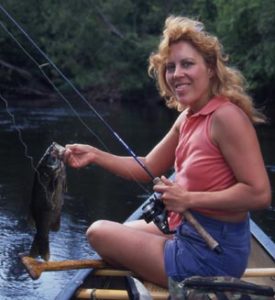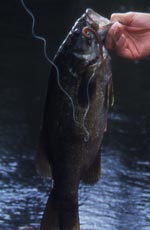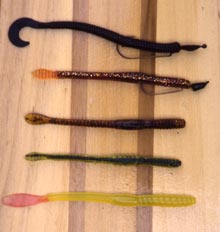Every year dozens of brand-new critters flood the tackle shops and catalogs. But small finesse worms often outperform many of the newer baits.
During the past decade there’s been an explosion of soft plastic baits. Every year it seems that dozens of brand-new critters in every size, shape and color imaginable flood the tackle shops and catalogs. With so many new products, some may feel that my singing the praises of a plastic bait that’s 20 years old is downright old-fashioned. However, I think anyone who really gives small finesse worms a fair try will see that they often outperform many of the newer baits.

Another smallie falls for a finesse worm

I really came to see how versatile and effective skinny 4-inch worms are when I was guiding about 15 years ago. I found that by using Berkley’s scented little 4-inch worms on 1/6 or 1/8th ounce slider heads, my clients could really work the bottom with minimal hang-ups. More importantly, they consistently caught smallmouth bass, lots of them, and big ones, even when the smallies were very inactive. Nowadays I may use various brands of worms in various colors, but this same basic method of Texas rigging a worm on a lightweight slider head is still a favorite practice of mine.
These little worms have a small enough diameter that the hook easily penetrates the plastic and consistently hooks the fish, even small fry, and even when you are using a light and flexible rod. (With many thick-bodied plastics that are Texas-rigged, consistently hooking smallmouth bass is difficult with rods rated only light or light-medium.) However, 4-inch worms still have a long enough profile to be highly visible to bass, even when they’re hoped or crawled through rocks. And I have seen hundreds of big smallmouth bass take these little worms, even in very low visibility water.
The most common way I fish a small worm is to let it hit bottom, then I immediately start working it back with short one-foot to 18-inch hops, keeping the rod tip at a 45-degree angle to the surface. Since they’re rigged on a jig head, bass won’t hold on to these baits indefinitely, so immediately drop the rod tip 2 or 3 feet when you detect a strike, take up the slack and hit ’em hard.

Five varieties of finesse worms
When smallmouth bass are in a less-active mood, increase your pause between hops. Sometimes letting the bait sit still on the bottom for 3 or 4 seconds with its tail waving enticingly is enough to make even finicky bass want to pick it up. And on areas with gravel or sand substrates, just slowly dragging the lure along the bottom is often deadly.
Naturally, finesse worms are effective for lake smallmouth bass, too. But I most often use them in moving water, and in rivers I have the most success with the curly tail varieties like Berkley’s. Worms seem especially deadly during the summer crayfish season. During this time colors like pumpkinseed, motor oil, camo and black pay off, depending on local water color.
Perhaps you’re a veteran angler who has put your little worms aside for newer plastics, or maybe you’re a more recent smallmouth bass convert and have never heard of these baits. Either way, I think you should definitely incorporate these great jigs into your angling repertoire.


No comments yet.